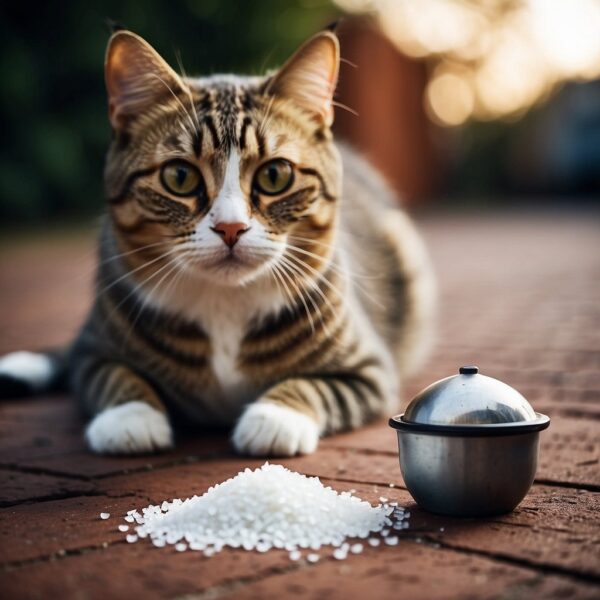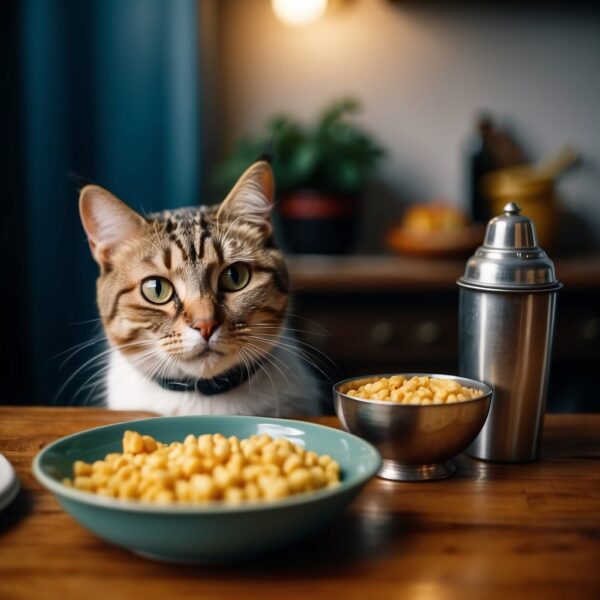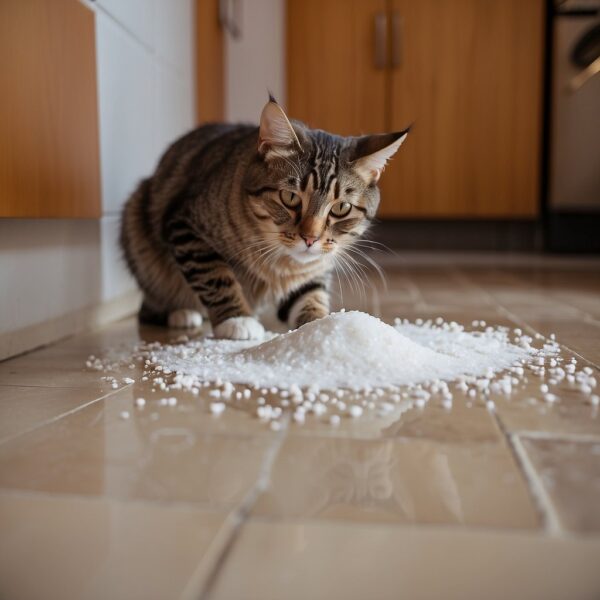
Risks of High Sodium in Cat Diet
Cats, like all animals, require a balanced diet to maintain their health. Salt, or sodium chloride, is an essential mineral in a cat’s diet, playing a critical role in nerve function and muscle movement, as well as fluid balance. However, the feline body needs salt in very limited quantities, and a cat’s natural diet usually provides an adequate amount. High sodium in a cat diet can lead to salt toxicity in cats. Most commercial cat foods are formulated to contain the right balance of sodium necessary for a cat’s well-being.
The issue arises when cats consume too much salt, which can occur if they are given access to human foods high in sodium or salt-containing treats not specifically designed for them. While a tiny amount of salt won’t harm a cat, excessive consumption can lead to salt toxicity, which is a serious and potentially life-threatening condition. Cat parents must be vigilant about their cats’ diet and understand the implications of excessive salt intake. Should a cat ingest a large quantity of salt, prompt veterinary attention is crucial to prevent the severe consequences that could follow.
Key Takeaways
- Salt is essential in small amounts for a cat’s diet but can be harmful in excess.
- Excessive salt intake in cats can lead to serious health issues, requiring veterinary care.
- Parents should monitor their cat’s salt consumption to avoid the risk of salt toxicity.

Understanding Salt in a Cat’s Diet
Salt, composed of sodium and chloride, is an essential mineral for cats, playing a critical role in various bodily functions. While some sodium is necessary in a feline’s diet, it’s important to understand the balance and the potential risks associated with high-salt foods.
The Role of Sodium in Cat Nutrition
Sodium is imperative for cats, aiding in electrolyte balance, fluid regulation, and the function of nerve and muscle cells. As obligate carnivores, cats naturally fulfill their sodium requirements through a meat-based diet without the need for added salt.
Risks of High-Sodium Diets
Excessive sodium intake can lead to health issues such as high blood pressure, heart disease, and kidney disease. Salt toxicity or sodium poisoning in cats can manifest as severe symptoms like excessive thirst, dehydration, and hypernatremia (too much sodium on the blood), particularly after ingesting human foods high in salt.
Cats’ Dietary Needs Compared to Humans
Contrary to humans, cats have more stringent dietary needs. Their taste receptors are less responsive to salt, and they do not crave or require high-sodium foods. Even small amounts of salt that are manageable for humans can be harmful to cats.
Safe Sodium Levels for Cats
Regulations by entities like the American Feed Control Officials suggest that cat food should contain at least 0.2% sodium for maintenance and proper growth. This often translates to 21-42 milligrams of sodium per day per body weight of the cat, depending on their size and health.
Identifying Low-Sodium Cat Foods
To ensure a cat’s diet is within the safe sodium levels, it is important to read pet food labels and choose products that do not have added salt or high-sodium content. Cat parents should focus on specifically formulated cat foods rather than human foods.
Common Household Salts and Their Effects
Besides table salt (sodium chloride), other salts like baking soda (sodium bicarbonate) and rock salt can pose dangers. These substances, when ingested by cats in quantities beyond their nutritional needs, can lead to adverse effects and should be kept out of reach.
Signs and Symptoms of Salt Toxicity in cats
Excessive salt intake can lead to salt toxicity in cats, which requires immediate attention. The condition is marked by a range of physical signs and behavioral changes that indicate a serious imbalance. Recognizing these symptoms is crucial for the health and well-being of feline companions.
Physical Signs of Salt Poisoning
When a cat has ingested too much salt, several physical symptoms may appear:
- Excessive thirst and urination: Indicators of the body trying to restore sodium balance.
- Vomiting and diarrhea: The body’s response to excessive salt, leading to dehydration.
- Seizures and tremors: Severe neurological symptoms due to sodium’s effect on brain activity.
- Incoordination and weakness: A result of altered electrolyte levels affecting muscle function.
- Coma: In extreme cases of salt toxicity, loss of consciousness can occur.
Behavioral Changes Indicating Excessive Salt Intake
Behavioral symptoms are equally as telling and can include:
- Decreased or poor appetite: Cats may lose interest in food despite the need for nutritional intake.
- Lethargy: A lack of energy or general weakness, a sign of systemic upset.
- Disorientation: Difficulty in moving or navigating familiar spaces, signifying neurological impact.
Immediate veterinary treatment is vital when these signs are observed to prevent further health deterioration. Time is of the essence to mitigate the effects of salt poisoning and ensure recovery.

Immediate Actions for Suspected Salt Poisoning
When a cat parent suspects their pet has ingested a harmful amount of salt, prompt and correct actions are crucial to mitigate the risks associated with salt toxicity. Acting swiftly can prevent the progression to severe symptoms such as vomiting, seizures, or even coma.
First-Aid Steps for Salt Toxicity
- Ensure Water Availability: Provide the cat with immediate access to fresh water to help dilute the excess sodium in the system.
- Monitor Symptoms: Closely observe the cat for any signs of distress such as excessive thirst, vomiting, or diarrhea, which could indicate salt poisoning.
When to Contact a Veterinarian
- Symptom Identification: If any symptoms such as vomiting, diarrhea, lethargy, or seizures are present, contact a veterinarian immediately.
- Professional Advice: Even in the absence of visible symptoms, seeking veterinary advice is recommended due to the potential for rapid onset of salt toxicity effects.
Professional Treatment for Salt Toxicity
- Veterinary Examination: The veterinarian will conduct a thorough examination to assess the severity of the salt poisoning.
- Electrolyte Balancing: Treatment often includes intravenous (IV) fluids to stabilize electrolyte levels and correct dehydration.
- Ongoing Monitoring: The cat will be monitored for improvement in symptoms and adjustments to the treatment plan as needed.
Prevention and Care Post-Treatment
- Dietary Adjustments: Post-treatment, the cat’s dietary salt intake should be carefully managed according to veterinary recommendations.
- Long-Term Monitoring: Pet parents should monitor water intake and watch for any recurring symptoms, ensuring their cat’s electrolyte levels remain stable.
In-Home Management of Salt Intake
Managing salt intake for cats is crucial to ensure their well-being since too much salt can lead to health issues, while an appropriate amount is necessary for proper bodily functions. Pet parents play a vital role in supervising their feline companion’s diet to maintain their health.
Proper Hydration for Cats
A fundamental aspect of managing salt intake is ensuring cats have constant access to fresh water. Cats need adequate hydration to help flush excess sodium out of their system. Cat parents should provide multiple water stations with clean water throughout the home, and consider the use of a cat water fountain to encourage more frequent water intake.
Selecting Appropriate Cat Treats
When choosing treats, opt for those low in salt and void of human food products like potato chips. Look for treats specifically formulated for cats, emphasizing nutritional needs over palatability alone. Taste buds in cats differ from humans, and they do not crave salty foods as people do, so a cat’s treat should be healthy rather than just tasty.
- Do:
- Choose treats labeled with low sodium content.
- Prefer natural over heavily processed options.
- Don’t:
- Give human snacks like potato chips or salty meats.
- Overfeed treats, even if they’re marketed for cats.
Understanding Cat Food Labels
Cat parents must read cat food labels to monitor sodium levels in their pet’s diet. Commercial cat foods typically contain the necessary amount of salt to meet nutritional needs. Sodium also serves as a preservative in pet food. However, pet parents should avoid brands that list salt amongst the first few ingredients, as this may indicate a higher sodium content.
- Nutritional Label Quick Facts:
- Guaranteed Analysis: Shows minimum and maximum levels of nutrients, including sodium.
- Ingredients List: Ingredients are in descending order by weight; closer to the top means more prevalent.
- Specific Nutrients: Some labels may detail exact amounts of sodium and chloride.
By adhering to these in-home management strategies, cat parents can help control their cat’s sodium intake and promote overall health.
Long-Term Health and Sodium Regulation
Regulating sodium intake is crucial for a cat’s long-term health, as it can prevent life-threatening conditions such as heart disease and kidney disease. Balancing a cat’s diet with the appropriate amount of sodium contributes to overall well-being and helps maintain optimal blood pressure levels.
Adjusting Diet for Age and Health Conditions
The dietary needs of cats vary with age and existing health conditions. For instance, obligate carnivores like cats require specific amounts of sodium in their diet for optimal health. However, pets with kidney disease, heart disease, or diabetes may need a modified diet with restricted sodium. It’s important for cat owners to:
- Consult a veterinarian to tailor their cat’s diet to its unique health needs.
- Adapt the diet over time to correspond with changes in the cat’s health.
Here is a simple table to summarize diet adjustments for age and health conditions:
| Age/Condition | Diet Adjustment |
|---|---|
| Kitten | Higher sodium for growth (within safe limits) |
| Adult Cat | Balanced sodium for maintenance |
| Senior Cat | Monitor sodium for potential health issues |
| With Kidney Disease | Reduced sodium to lessen kidney workload |
| With Heart Disease | Low sodium to manage blood pressure |
| Diabetic Cat | Monitor and adjust sodium as recommended by a veterinarian |
Adherence to guidelines provided by professionals and reputable sources ensures that sodium levels are within a safe range for the health and longevity of your pet.
Understanding Cat Behavior and cats eating salt
Cats possess specific taste receptors that guide their salt preferences, but as pet parents, it is crucial to manage their sodium intake to maintain their health and electrolyte balances.
Natural Salt Preferences in Cats
Cats’ taste buds are less sensitive to salt compared to those of humans. However, they do have taste receptors that can detect salty flavors. In their natural diet, cats would obtain the necessary amount of salt through the consumption of their prey, which contains trace amounts of sodium essential for maintaining their electrolyte balances and overall health. While domestic cats might show interest in salty foods, their innate preferences are usually well-regulated.
Avoiding High Sodium to prevent Salt toxicity in Cats
Excess sodium intake can lead to health problems in cats, including dehydration and imbalances in electrolyte levels, which may cause more severe conditions if left unchecked. It’s crucial for cat foods to contain the appropriate amount of salt, which according to general guidelines, should not exceed 42 milligrams per day. Pet parents should monitor their pets’ diets and limit the access to human food, which often contains higher levels of table salt than pet food designed for their specific dietary requirements.
Educating Family on Proper Feeding Practices
Understanding that cats’ dietary needs differ significantly from humans is key to preventing salt-related health issues. It is the responsibility of pet parents to educate all family members about the risks of feeding cats human food that often contains higher sodium content. Relying on quality cat foods that are formulated to meet their nutritional needs helps ensure that cats receive the correct amount of salt without the risk of overconsumption.
It is important to recognize that while salt is an essential part of a cat’s diet, balance is paramount for their well-being.

salt toxicity in cats: Frequently Asked Questions
In managing a cat’s diet, understanding salt intake is crucial due to its necessity for bodily functions and the risks of excessive consumption.
How much salt is safe for a cat’s consumption?
A cat requires a small amount of salt for its bodily functions; however, the safe limit is generally around 21 milligrams per day for an average-sized cat. Owners should always consult with a veterinarian to determine the specific needs of their pet.
Are there any risks if a cat ingests salted meat?
When a cat ingests salted meat, there is a risk of salt toxicity due to high sodium levels, which can lead to excessive thirst, urination, and even sodium ion poisoning.
What are the potential effects of salt on a cat’s paws?
Salt on a cat’s paws can lead to dryness, cracking, or irritation. In winter, when roads are salted, it’s important to wash a cat’s paws after outdoor walks to prevent these issues.
What should I do if my cat has ingested a significant amount of salt?
If a cat has ingested a large amount of salt, it may show signs of poisoning such as vomiting, diarrhea, lethargy, or seizures. In such cases, it’s imperative to seek immediate veterinary care.
Is it harmful for cats to eat salted fish?
Salted fish can be harmful to cats due to the high sodium contents, which could lead to salt toxicity. Providing a balanced diet specifically formulated for cats is essential.
Why might cats be attracted to salty foods?
Cats may be attracted to salty foods due to their taste and smell. However, pet owners should monitor and restrict their access to salty foods to avoid potential health issues.